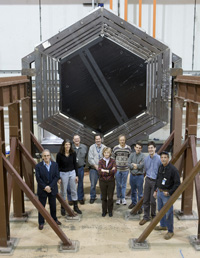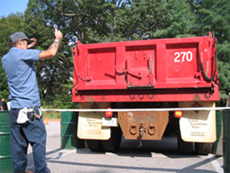|
Mon., May 7
2:30 p.m.
Particle Astrophysics Seminar - Curia II
Speaker: G. Thomson, Rutgers University
Title: Observation of the GZK Cutoff by the HiRes Experiment
3:30 p.m.
DIRECTOR'S COFFEE BREAK- 2nd Flr X-Over
4:00 p.m.
All Experimenters' Meeting - Curia II
Tue., May 8
3:30 p.m.
DIRECTOR'S COFFEE BREAK - 2nd Flr X-Over
THERE WILL BE NO ACCELERATOR PHYSICS AND TECHNOLOGY
SEMINAR TODAY
Click here for NALCAL,
a weekly calendar with links to additional information. |
Monday, May 7
- Wisconsin cheese
- Corned beef Reuben
- Stuffed chicken breast
- Mostaccioli al forno
- Chicken oriental wrap pineapple
- Assorted sliced pizza
- Pacific rim rice bowl
Wilson Hall Cafe Menu |
|
Wednesday, May 9
Lunch
- Roast pork loin
- Orange roasted carrots w/ honey
- Pea pod salad w/ radishes
- Apple walnut raisin strudel
Thursday, May 10
Dinner
- Salad of field greens w/ jicama, radishes, oranges, pine nuts & queso rico
w/ balsamic vinaigrette
- Beef short ribs in chipotle green chili sauce
- Cumin roasted sweet potatoes
- Strawberry sorbet w/ lemon sugar cookies
Chez Leon Menu
Call x4598 to make your reservation. |
|
|
MINERvA detector prototype offers neutrinos a new target
 |
| MINERvA's researchers will use a detector like this prototype to study neutrino reactions with the nuclei of lead, iron, carbon and helium. |
On April 12, MINERvA's 85 researchers marked the completion of the first prototype layer of their neutrino interaction detector. The prototype's outside is 99.5 percent iron and coats an inside that's made of plastic scintillator. A joke among the collaborators is that the prototype is like a Cadbury chocolate egg -- crunchy on the outside and gooey on the inside.
Since the layer is a prototype, it will not be installed in the NuMI beamline at the MINOS near detector, where the full MINERvA assembly will ultimately sit. The prototype at Wideband Lab weighs about 3,500 pounds and is about 4 meters tall, 3 meters wide and 4 centimeters thick.
MINERvA will observe for the first time what happens when the same beam of neutrinos interacts with the nuclei of four different materials: lead, iron, carbon and helium. Through the neutrino-nucleus reactions in the lead, iron, carbon and helium layers, MINERvA scientists will study the glue holding together protons and neutrons, said experiment cospokesperson Kevin McFarland of the University of Rochester.
"Studying neutrino interactions with quarks, and even the entire nucleus, are the goals of the high-energy and nuclear physicists who make up MINERvA," said cospokesperson Jorge Morfin of Fermilab.
Data collection is expected to begin in 2009 after two years of building the 108 layers of MINERvA. When completed, the entire MINERvA detector module will stretch about 5 meters. The Department of Energy's Office of Science approved funding for the construction of the project on March 30. Funding for the nuclear targets came from the National Science Foundation.
--Kate Raiford
|
Chemistry World,
May 3, 2007
Particle physics gets smaller
Plans for a prototype of an unusually simple, small particle accelerator have been unveiled by the University of Manchester.
The accelerator will deliver a continuous beam of high energy particles, says the leader of the £8.3 million project, Roger Barlow. 'This is more compact than the synchrotron, and much cheaper and simpler to operate. Once we have demonstrated that the principle works with a prototype, these could be built and run in many more institutes,' he told Chemistry World.
The unique feature that makes the machine so much simpler is that the magnets producing the magnetic field that accelerates the particles run with a continuous current.
'Synchotrons use an alternating current to steer the particles,' said Barlow. 'Although this idea is simpler, it has never been attempted before because there is doubt about what will happen to the beam if the magnets aren't perfectly matched.'
Read more
|
|
|
Plan ahead to look behind

When steering a vehicle through tight quarters, it's generally a good idea to use a "spotter" to reduce the risk of hitting things.
On March 30, 2007, a truck arrived at CERN Temporary Storage Building 609 to deliver material for the ATLAS detector. A CERN employee assumed the role of spotter and began guiding the truck into the building. While walking backwards, the spotter fell over a pallet and broke his hip. Subsequent investigation by CERN's Safety Commission determined that access to Building 609 was, indeed, partially obstructed.
Poor housekeeping can contribute to accidents by hiding hazards that already exist, as well as by creating new ones. Proper controls include maintaining neat work areas, keeping halls and floors free of slip and trip hazards, and removing fire hazards and waste materials. Housekeeping should be an ongoing activity, since periodic cleanups are usually ineffective in preventing accidents.
In the incident at CERN, it is also likely that the spotter was not maintaining full awareness of his environment. It is important to identify and address hazards and work control issues, which can be done by continuously monitoring the work area, while moving slowly. An even better approach is to first conduct a job site walk-down. It is also important for participants to discuss the work plan to ensure that everyone is aware of how the job will proceed. Procedures for work planning and hazard analysis are contained in Fermilab ES&H Manual Chapter 2060.
Safety Tip of the Week Archive
|
|
An article in the Friday issue of Fermilab Today listed incorrect dates for the upcoming Users Meeting. The correct dates are June 6-7. We regret the error.
|
|
Best-seller Einstein biography now available in the Library
The Fermilab Library has the new biography, Einstein: His Life and Universe. This recounting of the life of the foremost "celebrity physicist" is on Amazon's top-10 bestseller list. In his New Yorker review, "The valiant Swabian,"
John Updike calls the book a "thorough, comprehensive, affectionate new biography." You may reserve the book from the Library's online catalog. Please phone x3401 or email the Library for more information.
'Kiss Me Kate' discounts
Life imitates art when a bickering theater couple rekindle their backstage romance in spite of interruptions by his mistress, her Texas millionaire fiancée' and two hilarious gangsters out to collect a gambling I.O.U. -- all while putting on a musical version of Shakespeare's "The Taming of the Shrew." Save up to $29.00 per ticket. Dates, ticket prices and order information for this Broadway favorite can be found in the Recreation Office.
Upcoming Activities |
|